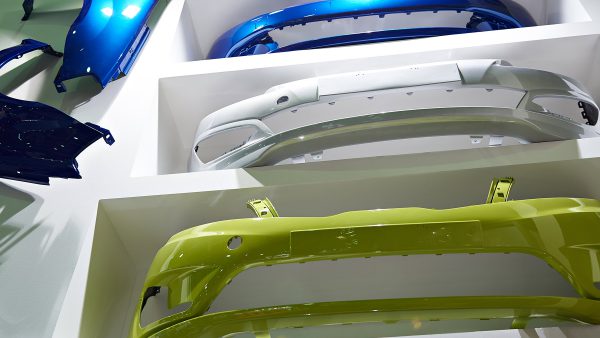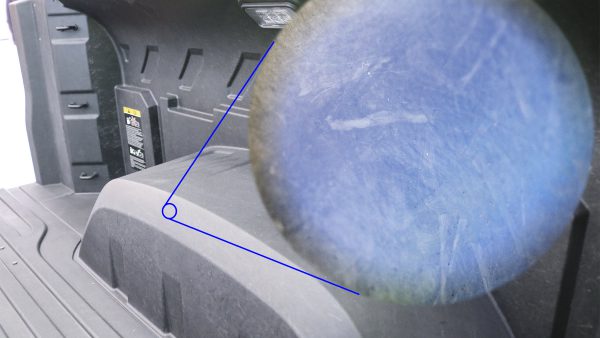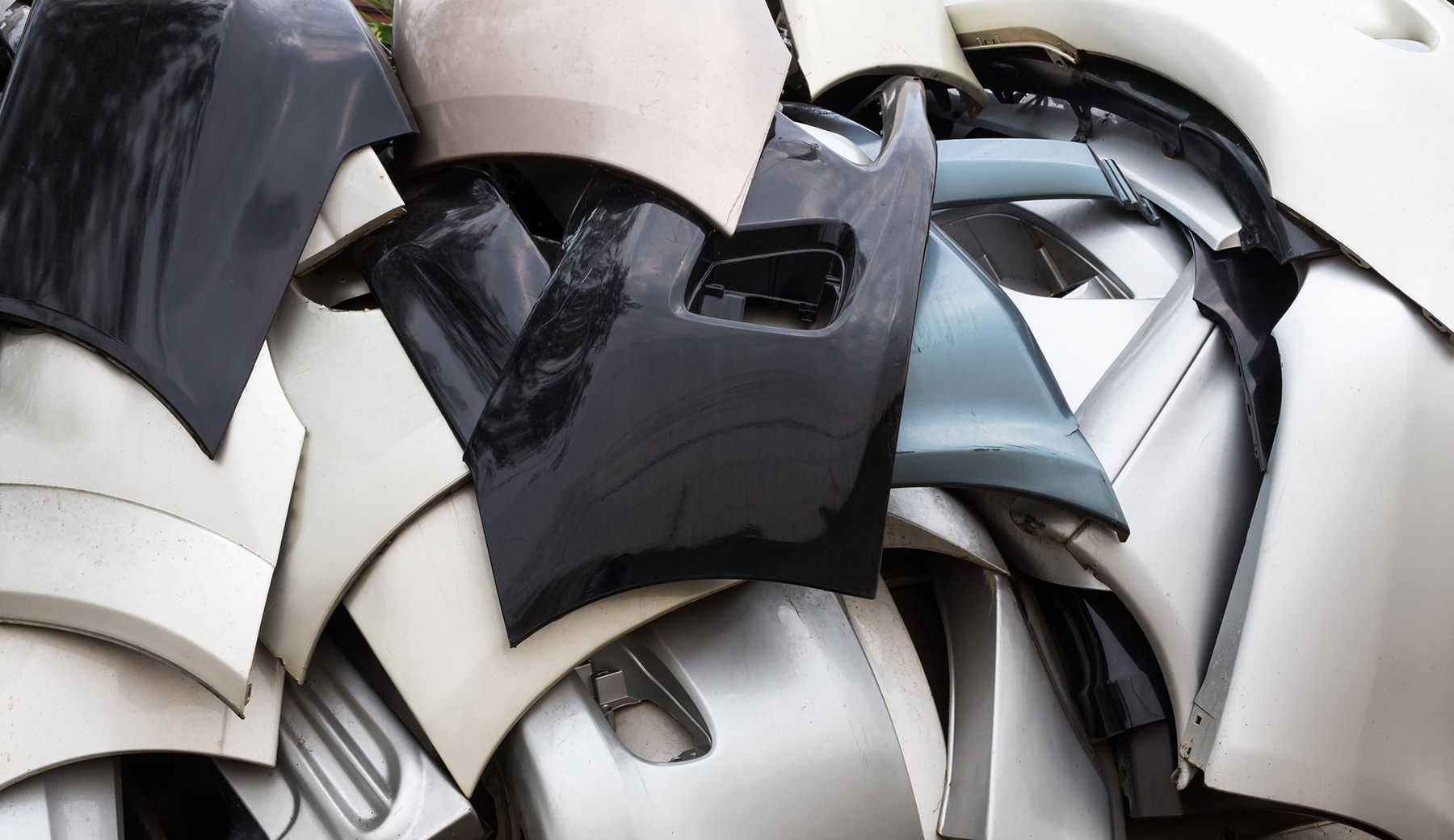Principles of circularity emphasize not only recovering materials at the end of their usable life but also reusing them in new products, refurbishing them to extend product lifecycles, and reducing the demand for finite raw materials.
Globally, the automotive community is increasingly focused on making it easier to disassemble end-of-life (EOL) vehicles, boosting EOL material recovery rates, and increasing the amount of recycled and reused material in new vehicle designs. For example, 50 of the 280 kilograms of plastics used in a Renault Espace come from recycled sources including closed-loop EOL plastics.26 Advanced plastics and polymer composites have the opportunity to play a significant role in improving automotive circularity in the following areas:
Collection and Dismantling
Design Impacts

The current recycling infrastructure is not optimized for the collection and sorting of end-of-life automotive polymers. Coordination across the recycling supply chain is needed to understand and demonstrate the value proposition of nationwide collection platforms for retrieving dismantled vehicles and automotive components.
Automakers are increasingly focused on designing vehicles for increased recyclability as well as easy and economic disassembly to extend vehicle lifespan through refurbishment, and to remanufacture materials into new automotive components (closed-loop) or into alternative applications (open-loop).
Opportunities for Advanced Plastics and Polymer Composites
Broadening participation in nationwide recycling initiatives, establishing new markets for recyclate materials, and streamlining activities between waste collection and manufacturing could help to reduce landfilling and improve the recyclability rate of post-consumer automotive advanced plastics and polymer composites.
Lifecycle tools and other long-term design strategies could help reduce technical and logistical barriers for EOL vehicle disassembly and improve recycled material recovery rates for automotive plastics and polymer composites.
Collaborative Activities
Recycling Infrastructure
| Near (2020–2022)Mid (2023–2025)Long (2026–2030) | |
|---|---|
| Engage existing automotive material recovery facilities to benchmark progress and motivate research in effective automotive disassembly/dismantling approaches | Near |
| Benchmark efforts in Europe to establish a nationwide closed-loop manufacturing infrastructure for effective retrieval of dismantled vehicles/components and post-consumer sorting and separation of recyclable plastics and polymer composites | Near |
| Collaborate with dismantlers on a study to quantify the value proposition for open-loop collection approaches of plastic parts (e.g., new recycle stream, feed for chemical recycling plants) | Near, Mid |
| Identify high-value secondary applications for upcycled EOL polymers | Near, Mid, Long |
| Launch a collaborative, holistic effort across multiple technology sectors to optimize the automotive EOL recycling infrastructure; determine funding requirements and create a unified voice and strategy for EOL vehicles | Near, Mid, Long |
| Fund (or enhance an existing) disassembly and remanufacturing shared R&D facility to demonstrate the feasibility of large-scale dismantling operations for EOL automotive plastics and polymer composites | Mid |
| Develop industry-wide vehicle fleet maintenance standards to ensure the consistent testing, refurbishment, replacement, and collection of end-of-life seating materials (i.e., for Level 5 autonomous vehicles) | Mid |
| Identify seed funding opportunities to demonstrate small-scale/regional collection platforms and advanced sorting technologies for EOL automotive plastics and polymer composites | Mid |
Designing for Recyclability and Disassembly
| Near (2020–2022)Mid (2023–2025)Long (2026–2030) | |
|---|---|
| Coordinate an industry-wide series of competitions, grants, and other creative and publicity-building efforts to demonstrate automotive designs which help improve the recovery rate of EOL automotive plastics and composites | Near, Mid |
| Establish industry standards to better define how the "recycled content" of a vehicle is quantified | Mid |
| Demonstrate high performance recycled plastics-intensive automotive designs | Mid |
| Design plastic and polymer composite automotive components for ease of disassembly/dismantling | Mid |
| Pursue innovative design approaches that fully account for ease of disassembly and recovery of advanced polymer and composite parts including plastic-metal-hybrid parts | Mid, Long |
Lifecycle Assessment
Design Impacts

Future shared and autonomous vehicles are expected to have higher usage rates and shorter lifespans which will increase the need for designs and materials solutions that extend overall vehicle service life. LCAs will help provide automakers with a clearer understanding of the cradle-to-grave energy use, environmental impacts, service life, and recyclability requirements of new automotive materials options.
Opportunities for Advanced Plastics and Polymer Composites
Using advanced plastics and polymer composites instead of alternative materials could save 89 million US gallons of gasoline and diesel over the lifetime of vehicles in North America produced in one year.27
Rigorous LCAs could help determine the environmental benefits of plastics manufacturing technologies—including conventional, bio-based, chemically recycled, and other recycled plastics technologies—which offer an opportunity to reduce lifecycle greenhouse gas emissions across the entire value chain.28
Collaborative Activities
Modeling and Impact Analysis
| Near (2020–2022)Mid (2023–2025)Long (2026–2030) | |
|---|---|
| *Establish an industry group or committee to identify and set LCA standards for automotive materials | Near, Mid, Long |
| Allocate funding for LCA benchmarking studies to understand the full lifecycle environmental and economic impacts of various cradle-to-grave scenarios | Near |
| Determine if the lack of accepted and reliable LCAs addressing advanced plastics and polymer composites is a true barrier or just a perceived barrier by soliciting feedback from OEMs on existing LCAs | Near |
| Create standardized LCA methods that are easier to use for automotive designers | Near |
| Conduct an LCA study to understand the potential impact of environmental regulations and strategies to improve the sustainability of recycled and reused automotive advanced plastics and polymer composites | Near, Mid |
| Create a technoeconomic model to study alternative open-loop remanufacturing pathways that convert recovered advanced plastics and polymer composites into fuels | Near, Mid |
| Coordinate with OEMs to establish a shared database for gathering anonymized manufacturing data (e.g., energy use) to increase the robustness of LCA prediction tools | Mid |
| Develop and apply AI tools within design and optimization software packages to accelerate materials discovery and deployment for automotive plastics and polymer composites | Mid |
| Conduct a comparative LCA demonstration study on a plastic or polymer composite component (e.g., liftgate, exterior body panel, truck bed, seat system and metallic counterpart); evaluate durability, serviceability, repairability, cost, etc. | Mid |
| Create a technoeconomic model to assess the feasibility of end-of-life vehicle dismantling processes for plastics-/composites-intensive automotive designs | Mid, Long |
| Launch a collaborative effort among key plastics recycling associations and facilities (e.g., Association of Postconsumer Plastic Recyclers) to conduct LCAs on behalf of automotive OEMs | Mid, Long |
Recovery and Sorting
Design Impacts

Without a clear value proposition or regulatory driver to recycle EOL vehicles, recycling organizations are unlikely to invest in technologies to identify and sort automotive materials.
Retrieved EOL materials must exhibit adequate aesthetic quality and mechanical performance to be remanufactured into automotive components. Automotive recyclers will require effective reprocessing technologies for extracting chemical additives and separating materials grades as well as best practices and guidelines for separating and recovering EOL parts for recycling.
Opportunities for Advanced Plastics and Polymer Composites
Advanced sorting technologies such as image recognition, near-infrared spectroscopy, and marker technologies (e.g., barcodes, invisible chemical markers) can enable high purity materials streams needed for remanufacturing vehicles with high levels of recycled plastics content.29
Industry-wide guidelines for collecting, sorting, and separating plastic from metal vehicle components can improve batch quality and reduce contaminant levels.30
Collaborative Activities
Identification and Sorting
| Near (2020–2022)Mid (2023–2025)Long (2026–2030) | |
|---|---|
| *Pursue high-speed NDT/NDE techniques for end-of-life sorting to rapidly identify grades of plastics and polymer composites for reuse and remanufacturing | Mid |
| Increase advocacy efforts to help OEMs/consumers understand differences between "low-cost" and "recycled" materials grades | Near |
| Support the development and funding of shared recycling centers to enable new techniques for material identification and sorting of end-of-life vehicles | Near, Mid |
| Launch a task force across automotive stakeholders and state and federal agencies to standardize test standards (i.e., high-speed NDE techniques) for rapid identification of end-of-life materials grades | Mid |
| Increase collaborative efforts in legislative, regulatory, and voluntary consensus standard development to ensure gradual shift toward advanced sorting strategies for vehicle recycling | Mid, Long |
Materials Recovery
| Near (2020–2022)Mid (2023–2025)Long (2026–2030) | |
|---|---|
| *Collaborate with state and local economic development groups and the automobile salvage industry on effective chemical and mechanical recycling strategies for non-commodity/mixed plastics | Near, Mid |
| Conduct a study to quantify the potential impact of innovative chemical recycling techniques for a broad range of automotive advanced plastics and polymer composites | Near |
| Seek inputs from interior automotive materials producers on common or standardized end-of-life materials recovery approaches; examine lessons learned from non-automotive sectors on establishing end-of-life recycling strategies | Near |
| Demonstrate recycling technologies that seek to maximize the recoverable energy and value of end-of-life plastics and polymer composites | Near, Mid |
Remanufacturing
Design Impacts

Global automakers use closed-loop recycling approaches to reduce material waste and manufacturing energy consumption by replacing virgin materials with recycled materials in the same production cycle. Closed-loop manufacturing approaches are not yet broadly adopted due to insufficient scale, supply chain coordination, and recycle quality.
Opportunities for Advanced Plastics and Polymer Composites
Recyclable thermoplastics can be reprocessed and remanufactured into new automotive components.
Most automotive manufacturers, including Ford and Toyota, recycle old or damaged parts and reuse them in new vehicle components (e.g., old bumpers in new bumper reinforcement cores).31
Some advanced plastic recycling and recovery (APRR) technologies can convert used plastics into new products, chemicals and chemical feedstocks, and transportation fuels without the need for pre-cleaning treatments.32
Collaborative Activities
Closed Loop Applications
| Near (2020–2022)Mid (2023–2025)Long (2026–2030) | |
|---|---|
| Conduct a study of closed-loop manufacturing models to remanufacture automotive components using recycled plastics; identify critical application areas | Near |
| Coordinate with OEMs to define application/material specifications, property standards, and targets for automotive components with high levels of recycled content | Near |
| Increase collaborative efforts among OEMs/Tier 1-2 suppliers to review best practices for remanufacturing with more recovered materials content | Near |
| Launch a demonstration program for novel automotive concepts that use end-of-life plastics and polymer composites (i.e., designed for ease of disassembly, repair, reuse) | Near, Mid |
| Conduct a demonstration project for the end-of-life disassembly and remanufacturing of multimaterial assemblies and components (e.g., seating) | Near, Mid |
| Standardize disassembly and remanufacturing approaches to make EOL automotive plastics and polymer composites easier to recycle; focus on high-volume applications (e.g., seats, instrument panels, air intake manifolds, body panels, air ducts) | Near, Long |

